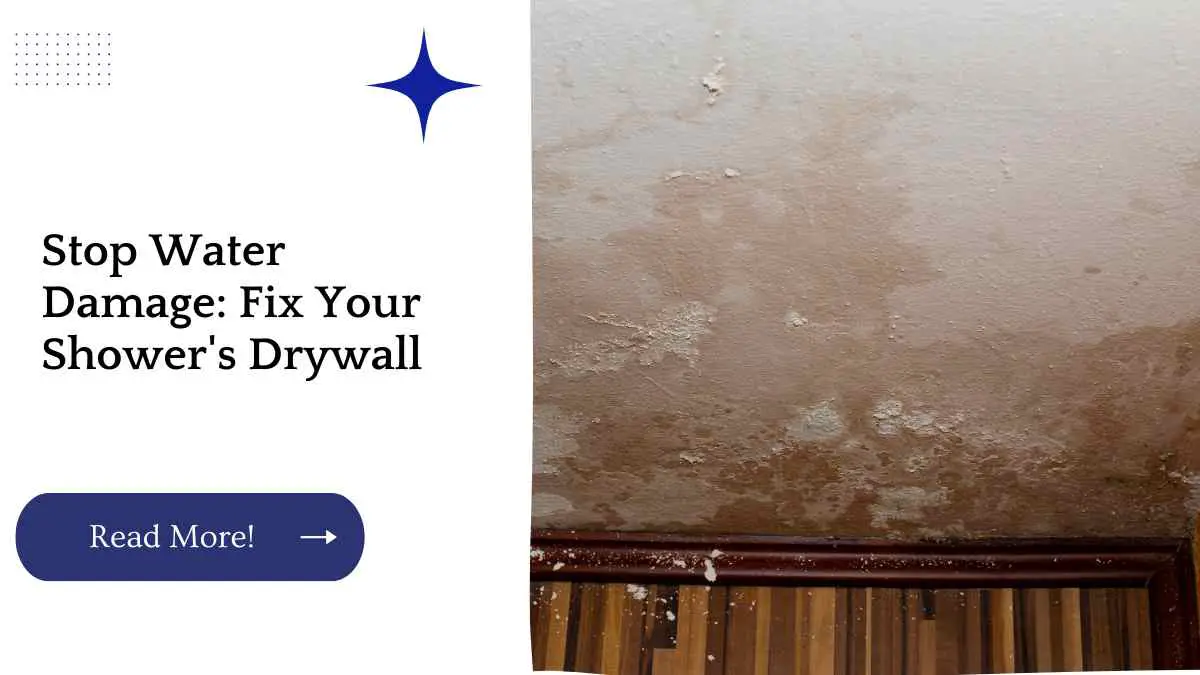Water damage in your bathroom can be frustrating and costly to repair. If you notice water damage on your shower’s drywall, it’s essential to take immediate action. In this article, we’ll cover everything you need to know to fix your shower’s drywall and prevent water damage.
| Key Takeaways |
|---|
| Water damage in your bathroom can be costly. |
| Signs of shower water damage include mold growth and water stains. |
| You’ll need tools like a drywall saw and joint compound to repair the drywall. |
| Waterproofing your shower and regular maintenance can prevent future water damage. |
| If you’re not comfortable with DIY repairs, consider hiring a professional. |
Understanding Shower Water Damage
What Causes Shower Water Damage?
Water damage in your shower can be caused by a variety of factors, including:
- Leaky pipes or fixtures
- Poor ventilation
- Improper installation
- Wear and tear over time
If you’re experiencing issues with your shower’s shut-off valves, don’t worry. Our guide on learning how to use them will help you gain the knowledge and confidence you need to navigate any plumbing challenge
Signs of Shower Water Damage
Signs that your shower’s drywall may be damaged by water include:
- Peeling or bubbling paint or wallpaper
- Mold growth
- Water stains or discoloration
- A musty odor
Assessing the Damage
How to Inspect the Drywall
To assess the extent of the water damage, you’ll need to inspect the drywall. You can do this by:
- Looking for visible signs of damage, like peeling paint or mold growth
- Pressing on the drywall to check for soft spots
- Tapping on the drywall to listen for a hollow sound
Dealing with a leaky shower can be a frustrating issue. Check out our guide on quick and easy fixes for basement showers to learn how to address this problem and save both time and money.
Determining the Extent of the Damage
Once you’ve inspected the drywall, you’ll need to determine the extent of the damage. This will help you decide whether you need to repair or replace the drywall. Common types of damage include:
- Minor damage, like surface water stains or small areas of peeling paint
- Moderate damage, like soft spots or small areas of mold growth
- Severe damage, like large areas of mold growth or soft spots throughout the drywall
Preparing for Repair
Tools and Materials Required
Before you start repairing your shower’s drywall, you’ll need to gather the following tools and materials:
- Drywall saw
- Joint compound
- Drywall tape
- Sandpaper
- Paint
Choosing the right drainage pipe for your driveway is a crucial decision for any homeowner. To make an informed choice and avoid potential issues, check out our guide on finding the right drainage pipe and enjoy peace of mind.
Removing the Damaged Drywall
To repair your shower’s drywall, you’ll need to remove any damaged drywall. This may involve cutting out the damaged section with a drywall saw.
Repairing the Drywall
Replacing the Drywall
If the damage is severe, you may need to replace the drywall entirely. To do this:
- Measure the size of the damaged area
- Cut a new piece of drywall to fit the space
Taping and Mudding the Seams
To tape and mud the seams, follow these steps:
- Apply drywall tape over the seam between the new and existing drywall.
- Apply joint compound over the tape using a trowel or putty knife.
- Smooth out the joint compound and let it dry according to the manufacturer’s instructions.
- Repeat this process two or three times, sanding the joint compound between each layer.
If you’re tired of dealing with grease buildup in your drains, check out our guide on cleaning your kitchen drain to learn some useful DIY solutions for a clearer and free-flowing drain
Sanding and Painting the Drywall
Once the joint compound has dried, sand the surface with sandpaper to create a smooth finish. Then, apply paint to match the existing color of your bathroom.
Preventing Future Water Damage
Applying Waterproofing Membrane
To prevent future water damage, consider applying a waterproofing membrane to your shower walls. This can be done using a brush or roller and can help prevent water from penetrating the drywall.
Proper Use of Shower Curtains
Proper use of shower curtains can also prevent water damage. Be sure to close the curtain fully when showering and allow it to dry completely after each use.
Regular Maintenance
Regular maintenance can also help prevent water damage. This includes checking for leaks, cleaning the shower regularly, and maintaining proper ventilation.
Hiring a Professional
When to Call a Professional
If you’re not comfortable repairing your shower’s drywall, or if the damage is severe, consider hiring a professional. A professional can assess the extent of the damage and provide expert repairs.
How to Find a Reliable Professional
To find a reliable professional, ask for recommendations from friends or family, or search online for reputable contractors in your area. Be sure to check references and ask for proof of insurance before hiring anyone.
Maximize your bath time and ensure you have sufficient hot water with our guide on hot water solutions. From water heaters to plumbing maintenance, get the tips you need to create a relaxing and enjoyable bath experience.
Further Reading
Here are some additional resources that can help you repair water damage in your bathroom:
How to Repair a Water-Damaged Wall in the Bathroom: This article provides step-by-step instructions for repairing water damage in your bathroom walls, including tips on how to identify and fix the problem.
Help Remedying Water Damage at Drywall Outside of Shower: This forum thread offers advice from professionals and DIYers on how to fix water damage on drywall outside of the shower.
How to Repair Your Water-Damaged Bathroom Wall: This comprehensive guide covers everything you need to know about repairing water damage in your bathroom walls, including how to assess the damage, prepare for repairs, and prevent future damage.
Final Thoughts
Water damage in your shower can be a frustrating and costly problem, but with the right tools and knowledge, it can be fixed.
Remember to inspect your drywall regularly, practice proper maintenance, and consider hiring a professional if you’re not comfortable with DIY repairs. By taking these steps, you can stop water damage in its tracks and enjoy a clean, dry bathroom for years to come.
FAQs
Can I repair water-damaged drywall myself?
Yes, you can repair water-damaged drywall yourself with the right tools and materials. However, if the damage is severe or if you’re not comfortable with DIY repairs, consider hiring a professional.
How do I know if my shower’s drywall is damaged by water?
Signs of water damage on your shower’s drywall include peeling paint, mold growth, water stains or discoloration, and a musty odor.
Can waterproofing my shower prevent future water damage?
Yes, applying a waterproofing membrane to your shower walls can help prevent future water damage by preventing water from penetrating the drywall.
How often should I inspect my shower’s drywall for water damage?
It’s a good idea to inspect your shower’s drywall for water damage at least once a year, or more often if you notice any signs of damage.
How can I maintain my shower to prevent water damage?
Maintaining your shower can help prevent water damage. This includes checking for leaks, cleaning the shower regularly, and maintaining proper ventilation.

Hellen James is the author of the blog and a licensed plumber with over 15 years of experience. She shares her knowledge and experience in plumbing and drainage through insightful and informative articles

